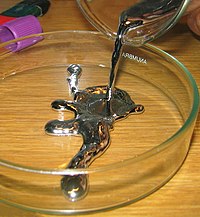
Photo from wikipedia
An electrokinetic-assisted phytoremediation test using maize (Zea mays L.) was conducted in order to assess the role of the electric field on the enhancement of plant uptake and degradation of… Click to show full abstract
An electrokinetic-assisted phytoremediation test using maize (Zea mays L.) was conducted in order to assess the role of the electric field on the enhancement of plant uptake and degradation of the moderate polar pesticide atrazine in spiked soils. Twelve different treatments, including two different initial atrazine soil doses (5 and 10 mg kg-1) and two different values of the electric field applied (2 and 4 V cm-1), together with the corresponding control treatments without plants and/or without electric current, were tested. The application of an electric field during a period of 4 h a day and with periodical polarity inversion (each 2 h) did not caused significant changes in soil pH; moreover, maize plants increased the buffering capacity of the soil. The application of an electric field of 2 V cm-1 led to a slight decrease on maize biomass while the accumulation of atrazine and its main metabolites in plant tissues was significantly enhanced. On the overall, the yield of atrazine removal by electrokinetic-assisted phytoremediation with maize was increased up to 36.5% with respect to the phytoremediation process without electricity. On our knowledge, this work is the first one specifically focused on the removal of organic pollutants from soils by using the combination of phytoremediation and electrokinetic remediation.
Journal Title: Journal of environmental management
Year Published: 2018
Link to full text (if available)
Share on Social Media: Sign Up to like & get
recommendations!